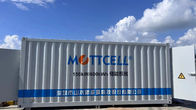Under the frequent rainstorms, the battery safety issues raised by the old student
2022-07-07
The recent heavy rains in Guangdong have caused serious water accumulation in many low-lying areas, and countless vehicles have to wade through the water, and have even been soaked in the water. At this time, the problem arises: Even a model as mature as a fuel-powered model may fall down when wading in water. What about my new energy vehicle? Is it safe enough that if I don't drive, will the battery die in water? Even more, will spontaneous combustion occur?
Whether the electric vehicle battery is waterproof or not, or whether it is afraid of water, in fact, mainly depends on three aspects, the battery, the battery management system and the battery pack. Why do you say that? First of all, if the vehicle is wading in water, it will lead to the nest or damage. It must have a path: the water enters from the outside of the vehicle, it first touches the sealing protection outside the battery pack, and after breaking through the protection, it will enter the second layer, that is, the system management between batteries in series. Protection, the last line of defense is the waterproof ability of a single battery itself. These three layers of protection build three lines of defense for the water wading performance of new energy vehicles.
Therefore, we cannot generalize whether new energy vehicles are afraid of water or not. Each vehicle, with different batteries, battery packs and management systems, will lead to differences in waterproof performance. Let's start with a single battery and introduce a standard here, which is "IPX7". IPX7 is an indicator of product protection safety level. This set of standards is used to measure the product's ability to protect against dust inhalation and short-term immersion, and IPX7 is almost the highest standard that most civilian enterprises can achieve at present. By the way, every battery in the new energy vehicle on the market at least meets the IPX7 standard.
In the assembly and manufacture of battery systems and chassis complete vehicles, manufacturers also consider various application environments and factors. It includes a series of problems such as blisters, high temperature, vibration, bumps, impacts, and drops. Therefore, the battery pack has been strictly sealed. Under normal circumstances, water cannot enter the interior of the battery and the control wiring.
Of course, it is not ruled out that due to the aging of circuit components and physical damage, the protective ability of the battery is weakened after the corrosive liquid corrodes. thereby increasing security risks.
Therefore, Shenzhen Mottcell New Energy said that although the probability of battery safety problems is very small in rainy days and soaking in water, it is still recommended to park at a higher place in rainy days. Try not to charge and use it in a humid or rainy open air environment. Battery technology is also constantly improving. The safety of new energy vehicles will become more and more guaranteed. At least in terms of water wading performance, many standards and tests have taken them into consideration, so we don’t need to worry too much in our daily car life.
-
2022-06-28
-
2023-02-18
-
2022-02-18
-
2022-02-18



